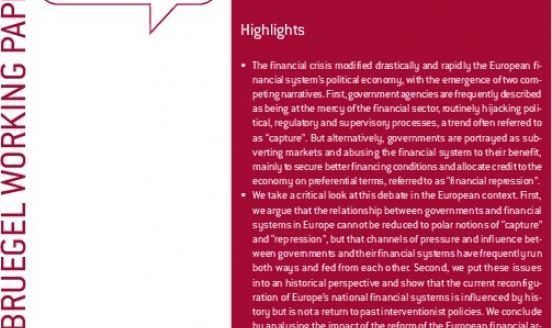There is no such thing as EFSF leverage without the ECB
On July 21st, European Heads of States designed the outline of a new Greek program which involved some private sector involvement and added some 109bn euros of financial commitments from the official sector. This means that of the EFSF’s 440bn euros of effective lending capacity, 17.7bn have been committed in the Irish program (plus 22.5bn by the EFSM and 22.5bn by the IMF), 26bn have been committed for the Portuguese program and 109bn for the new Greek program. Some of this might eventually be assumed by the IMF when it makes up its mind about a new Extended Fund Facility program for Greece but in the meantime, and for all intents and purposes, one should consider that the EFSF has only 287bn of resources available left.
This is relatively small if this is to be used to intervene in secondary debt markets and if one wants to use it as a credible backstop for national governments in their efforts to recapitalize their national banking systems. As a result, in the last few weeks, policymakers have explored a range of possible options to augment the EFSF’s firepower. But most of these solutions had important drawbacks. First, they all required a change in the framework agreement of the EFSF and therefore another long and hectic round of ratification that no policymaker wanted to endure; second they required a high degree of cooperation with the ECB. Because of these political challenges, all of these options have been dismissed and instead, the solution that is very likely to be adopted by the European Council on Sunday is akin to a credit insurance where the EFSF makes a partial guarantees against first loss in the event of a default or a restructuring. A quick back of the envelope calculation suggests that if the guarantee covered 20% of the new issue, it would allow leveraging the remaining funds in the EFSF five times. After some of the remaining funds are used for banks recapitalization (say 80bn euros), this would raise the firepower of the EFSF to just over a trillion euros. This is smaller than what could have been achieved through other solutions but size doesn’t always matter.
On paper, this solution has some merits because it is expedient and because it ought to reopen the primary debt market for sovereigns that are mainly suffering from self-fulfilling runs and could therefore achieve lower and stable borrowing costs thereby stabilizing debt dynamics automatically.
But it is in fact fraught with complications that are very likely to make it fail. The entire proposal rests on the premise that financial markets are now shunning these debts because of marginal doubts about their recovery value in the case of a credit event and that therefore by guaranteeing a small portion of this debt, the credit enhancement will comfort doubtful investors. This is an inadequate assessment. Financial investors have experienced tremendous price volatility in the last year, which now constrains a wide range of natural buyers who have been forced to adjust the size and duration of their portfolios accordingly. These investors are not driven by expected recovery value but by price volatility, this solution will not change their reaction function at all. For those investors that could be comforted by a degree of credit enhancement, it might be too small to be really enticing. Barring some friendly exceptional instances, experience is that when countries default or restructure, it tends to involve larger haircuts than the credit enhancement would offer.
In addition, setting a guarantee for any arbitrarily given percentage might just validate the underlying fear that these sovereign debt are not really risk free and that Greece’s restructuring wasn’t in fact a unique case, something that the European Council has tried to convince financial markets for months.
Last, investors will quickly come to treat the new and old debt as fundamentally different which will create a two tier market where the newly issued debt will effectively be treated as Senior to the existing stock making secondary market conditions even more challenging than they currently are, possibly leading the existing debt to trade at a discount to the primary market roughly equal to the credit enhancement provided to the new debt. This segmentation will set in motion another round of forced selling dynamics, weighing further on banks balance sheets and financial stability ultimately forcing the ECB to intervene in the secondary market more than it currently is in order to avoid contagion to other countries. This solution is therefore optically pleasant but is very likely to be practically ineffective.
But with all its flaws and risks, this solution opens some doors. The ECB might be one of these actors that could be compelled to hold more of this debt with such a credit enhancement. It won’t be able to buy them directly in the primary market due to the non-monetary financing clause of the Treaty but it will probably prove more incline to buy larger amounts of this debt in the secondary market because it will be deemed safer. Yet all in all, the idea that one can leverage the EFSF without the ECB is a fantasy. The reality is that the ECB will have to be even more involved with this solution than it would have with any of the other ones. Constructive ambiguity and its associated collateral damage will have to stay with us for longer.


